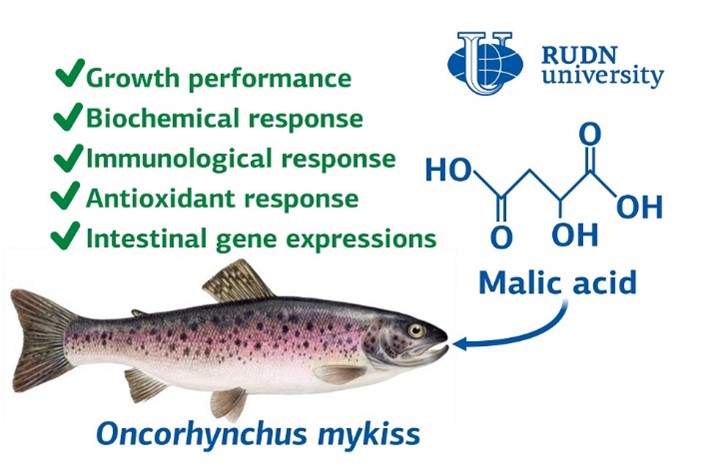RUDN University veterinarians: shallots will improve immunity and growth of trout

The increase in the volume of the fishing industry forces scientists and entrepreneurs to look for ways to optimize. Among other things, it is necessary to achieve maximum feed efficiency — so that the fish eat all the intended food and gain weight as quickly as possible. This task becomes more difficult in conditions where fish live in cramped tanks and interfere with each other. Because of this, they are malnourished and their immunity is weakened. To prevent disease, industry uses antibiotics—often incorrectly and unnecessarily. A RUDN veterinarian with colleagues from Iran, Italy and Thailand showed that instead, you can use a harmless natural additive to the feed — shallot extract.
“From 5 to 15% of the feed is not eaten by the fish. Overcrowding increases the incidence of injury and competition for space and food. At the same time, the risk of immune suppression and susceptibility to disease increases. Growth and efficiency of feed absorption are reduced. Excessive and sometimes inappropriate use of antibiotics leads to the emergence of resistant strains of bacteria, environmental pollution, and the transfer of antibiotic residues to other species, including humans. Therefore, over the years, researchers have been trying to find a suitable alternative to solve these problems,” Morteza Yousefi, Associate Professor of the Department of Veterinary Medicine at RUDN University.
Shallots are known for their antimicrobial, anti-inflammatory and antioxidant activities. Therefore, the authors chose it for the study. Veterinarians divided the rainbow trout fry Oncorhynchus mykiss into five groups. Four groups, along with their regular food, received a shallot supplement at different concentrations — 0.5, 1, 2 and 3%. Fish from the fifth group were fed only food. After 60 days of the experiment, veterinarians compared the degree of feed absorption, rate of weight gain, and biochemical blood parameters.
The fish that received a 2% shallot supplement gained weight better than others during the experiment — 36 grams versus 27 grams in the control group. The natural supplement also increased the concentrations of globulin and albumin proteins, the antibacterial agent lysocycime and other substances responsible for the immune response. Improvements were observed at any concentration of the natural supplement, however, in terms of the sum of symptoms, the 2% supplement performed best.
“The diet enriched with shallots affected the biochemical parameters of the blood of trout fry. After the
60-day trial, we noticed a significant increase in total proteins, albumin, and globulin in the blood. This indicates an improvement in immune parameters. All indicators point to the usefulness of shallot extract with remarkable consistency. The optimal level was from 1 to 2%. However, for reasons of economy, an extract concentration of 1% is recommended for use in aquaculture,” Morteza Yousefi.
The results were published in the journal Aquaculture.
RUDN summarized the results of the scientific competition "Project Start: work of the science club ". Students of the Faculty of Physics, Mathematics and Natural Sciences have created a project for a managed queuing system using a neural network to redistribute resources between 5G segments. How to increase flexibility, make the network fast and inexpensive and reach more users — tell Gebrial Ibram Esam Zekri ("Fundamental Computer Science and Information Technology", Master's degree, II course) and Ksenia Leontieva ("Applied Mathematics and Computer Science", Master's degree, I course).
The National Demographic Report, 2023 Demographic Well-Being of Russian Regions (hereinafter - the National Demographic Report) was prepared by the scientific team of the Institute of Demographic Studies of the Federal Research Center of the Russian Academy of Sciences, the Vologda Scientific Center of the Russian Academy of Sciences, Peoples' Friendship University of Russia, the Center for Family and Demography of the Academy of Sciences of the Republic of Tatarstan, as well as with the participation of leading scientists from the Republic of Bashkortostan, Stavropol Krai, Volgograd, Ivanovo, Kaliningrad, Nizhny Novgorod, Sverdlovsk Oblasts and Khanty-Mansi Autonomous Okrug–Yugra.
RUDN summarized the results of the scientific competition "Project Start: work of the science club ". Students of the Faculty of Physics, Mathematics and Natural Sciences have created a project for a managed queuing system using a neural network to redistribute resources between 5G segments. How to increase flexibility, make the network fast and inexpensive and reach more users — tell Gebrial Ibram Esam Zekri ("Fundamental Computer Science and Information Technology", Master's degree, II course) and Ksenia Leontieva ("Applied Mathematics and Computer Science", Master's degree, I course).
What is your first association with the word “laboratory”? Flasks and beakers? Microscopes and centrifuges? Yes, many of us would answer the same way.
The National Demographic Report, 2023 Demographic Well-Being of Russian Regions (hereinafter - the National Demographic Report) was prepared by the scientific team of the Institute of Demographic Studies of the Federal Research Center of the Russian Academy of Sciences, the Vologda Scientific Center of the Russian Academy of Sciences, Peoples' Friendship University of Russia, the Center for Family and Demography of the Academy of Sciences of the Republic of Tatarstan, as well as with the participation of leading scientists from the Republic of Bashkortostan, Stavropol Krai, Volgograd, Ivanovo, Kaliningrad, Nizhny Novgorod, Sverdlovsk Oblasts and Khanty-Mansi Autonomous Okrug–Yugra.